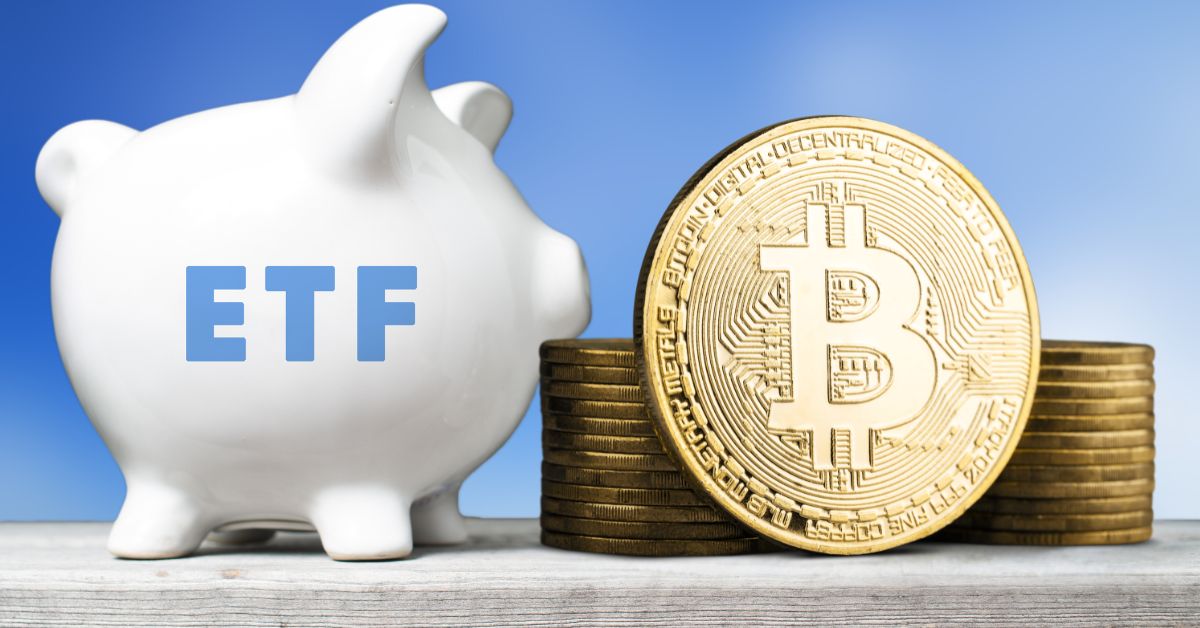
Shocking Truth About Bitcoin ETFs: Strategy To Win Big


Bitcoin ETFs (Exchange Traded Funds) have been getting lots of attention as a convenient way to get exposure to Bitcoin without directly holding the asset.
With major institutional players now backing Bitcoin ETFs, many investors are eager to jump on the crypto bandwagon.
However, given Bitcoin’s volatility and the complexities of the ETF structure, it’s essential to adopt a risk-managed approach.
While Bitcoin ETFs sound safe, there are a number of hidden risks involved, and in this article we’ll explore how you can engage with Bitcoin ETFs while minimizing risk and maximizing reward.
Understanding BItcoin ETFs
What Are Bitcoin ETFs?
Bitcoin ETFs track the price of Bitcoin, allowing investors to gain exposure to the asset without directly owning it.
Unlike traditional ETFs that might hold a basket of assets, Bitcoin ETFs typically hold only Bitcoin, which means investors are exposed entirely to Bitcoin’s price movements.
There are two main types of Bitcoin ETFs: spot ETFs, which hold actual Bitcoin, and futures-based ETFs, which track the future price of Bitcoin.
Why all the hype?
Bitcoin ETFs enable institutional investors, including pension funds and asset managers, to participate in the crypto market through regulated and familiar financial products.
This potential influx of institutional capital has excited many market commentators who believe this could drive significant demand for Bitcoin, possibly causing prices to skyrocket.
But is it all hype?
While institutional involvement lends credibility, investors must still recognize the fundamental risks associated with Bitcoin’s volatility, AND the additional layers of risk tied to the ETF structure, which I’ll get into shortly.
Do Bitcoin ETFs increase or reduce risk?
Institutional Involvement
While Bitcoin ETFs offer easier access through traditional brokerage accounts, their institutional backing introduces another layer of risk.
Investors are not only exposed to Bitcoin’s volatility but also to risks related to ETF management, including liquidity risks, tracking errors, and fees.
Although regulated custody systems mitigate certain operational risks, this additional complexity adds another dimension of risk that does not exist when holding Bitcoin directly.
ETF Illusion
Calling Bitcoin ETFs “ETFs” gives many investors a false sense of security.
Traditional ETFs hold baskets of diversified assets, such as shares of various companies or commodities, each with its own intrinsic value.
However, Bitcoin ETFs are fundamentally different.
Bitcoin itself has no intrinsic value—there are no underlying earnings, dividends, or physical assets backing it.
This is in stark contrast to ETFs like SPY, which holds a diversified portfolio of S&P 500 companies, each with business operations, assets, and cash flows that give them tangible worth.
Investors must understand that labeling it an ETF doesn’t change Bitcoin’s speculative nature, nor does it reduce its volatility.
Trading Bitcoin ETFs vs. Investing
Why Trading Is Preferred for Volatile Assets
One of the biggest causes of people losing money in the markets is not drawing a clear distinction between trading and investing.
Trading involves short-term strategies aimed at capitalizing on price movements, while investing focuses on long-term wealth accumulation through asset growth.
Trading volatile assets like Bitcoin requires an active approach to manage risk more effectively.
Investors who mistakenly apply a buy-and-hold strategy to volatile assets may find themselves exposed to significant losses during downturns.
By contrast, traders can limit their exposure to volatile markets through well-timed entries and exits, making use of technical indicators to guide their decisions.
Trading allows more flexibility in responding to price swings, while long-term investors might be stuck holding through large drawdowns.
Bitcoin is a Volatile Asset (even if they call it an ETF)
Bitcoin is known for its dramatic price swings, which make it more suitable for active trading strategies rather than long-term investing.
Traders can capitalize on Bitcoin’s volatility by using swing trading, day trading, or momentum trading.
These strategies allow for more control over risk, enabling traders to limit exposure during downturns by using stop losses, for example, and take advantage of upward trends.
These aren’t passive buy and hold strategies and require consistent monitoring and technical analysis but offers an approach better aligned with the nature of Bitcoin.
The Pitfalls of Long-Term Holding
While many investors may consider holding Bitcoin ETFs long-term, this exposes them to the full extent of Bitcoin’s volatility.
A sharp decline in Bitcoin’s price could result in significant drawdowns, making long-term holding less appealing for risk-conscious investors.
Remember, you need to make 100% to recover from a 50% loss. Think about it.
In a highly volatile market, long-term investors could find themselves caught in extended periods of price decline without the ability to exit quickly, or even at all.
This is because Bitcoin has got no intrinsic value.
I touched on this earlier, but it bears repeating.
You see, unlike stocks, which represent ownership in a company that produces goods or services, Bitcoin is purely a speculative asset.
Shares of companies have intrinsic value because companies generate profits, pay dividends, and hold physical or intellectual property. In contrast, Bitcoin has no inherent income stream or underlying asset base.
Even ETFs like SPY or QQQ hold diversified portfolios of companies with intrinsic value, making them fundamentally different from Bitcoin ETFs.
Investors holding traditional ETFs own shares in profitable businesses, while holding a Bitcoin ETF only ties your fortune to speculative market sentiment – and the movement of just one thing – Bitcoin!
Portfolio Sizing for Long-Term Investors
For those who are determined to gain long-term exposure to Bitcoin through Dollar Cost Averaging (DCA), it’s crucial to manage risk by properly sizing the portfolio.
Bitcoin should only represent a small portion of a broader investment strategy.
Investors should ensure that Bitcoin ETFs represent only a small fraction of their overall portfolio, typically no more than 5-10%, depending on their risk tolerance.
Allocating a small percentage of the overall portfolio to Bitcoin ETFs helps ensure that Bitcoin’s price swings do not jeopardize the overall stability of the portfolio.
This way, even if Bitcoin experiences extreme volatility, the investor’s broader portfolio remains resilient.
When DCA Makes Sense
DCA is most useful for investors who believe in Bitcoin’s long-term potential but want to reduce the risk of buying at the wrong time.
By investing a fixed amount regularly, investors can avoid trying to time the market and benefit from averaging their purchase price over time.
However, they must remain disciplined and ensure that their exposure to Bitcoin remains within a comfortable range.
Monitoring and Adjusting Allocation
Investors who adopt DCA must periodically review their portfolio to ensure that the Bitcoin ETF allocation does not become over-weighted.
If Bitcoin performs well and grows to take up a larger portion of the portfolio, it’s essential to rebalance and reduce the Bitcoin allocation to avoid excessive risk.
Regular monitoring and adjustments will help maintain a balanced, risk-conscious portfolio.
The Risks of Bitcoin ETFs
Volatility and Price Swings
Bitcoin’s price history is characterized by sharp rises and sudden falls, and Bitcoin ETFs inherit these fluctuations.
This volatility can lead to significant price swings within the ETF, which may not be suitable for every investor.
The price movements of Bitcoin ETFs are directly tied to the movements of Bitcoin (and only Bitcoin), which has experienced declines of over 50% in a matter of weeks in past cycles.
ETF Structure and Operational Risks
Bitcoin ETFs add an additional layer of complexity through their structure.
Investors are now exposed to management fees, potential liquidity issues, and tracking errors.
For example, futures-based Bitcoin ETFs, which track the price of Bitcoin futures rather than Bitcoin itself, may not always closely follow Bitcoin’s spot price.
Moreover, while the involvement of reputable institutions like BlackRock and Fidelity provides confidence, it also introduces counterparty risks associated with the management of these ETFs.
Increased Layer of Risk
Though Bitcoin ETFs simplify access to Bitcoin, they do not eliminate risk.
In fact, they introduce an additional layer of risk by adding complexity to the investment process.
Investors now face not only the inherent volatility of Bitcoin but also potential operational failures of the ETF provider.
These risks could materialize in the form of tracking discrepancies, sudden liquidity shortages, or increased fees, which may affect overall returns.
Conclusion
Balancing Trading and Investment Approaches
Bitcoin ETFs provide a convenient way to gain exposure to Bitcoin without holding the cryptocurrency directly, but they come with their own set of risks.
For most, active trading strategies offer better control and flexibility in managing Bitcoin’s volatility.
However, for those who opt for long-term exposure through DCA, portfolio sizing is critical to prevent overexposure to Bitcoin’s price fluctuations.
Final Thoughts
Bitcoin ETFs present exciting opportunities, but they must be approached with caution.
Whether you choose to trade actively or invest for the long term, it’s essential to understand the risks involved and manage your exposure carefully.
A disciplined approach to trading or investing will help navigate Bitcoin’s volatile nature while maximizing potential gains and minimizing risk.
Disclosure: The author is currently invested in a Bitcoin ETF but limits this to 1% of his portfolio. The author may also trade cryptocurrencies from time to time.
























Recent Comments